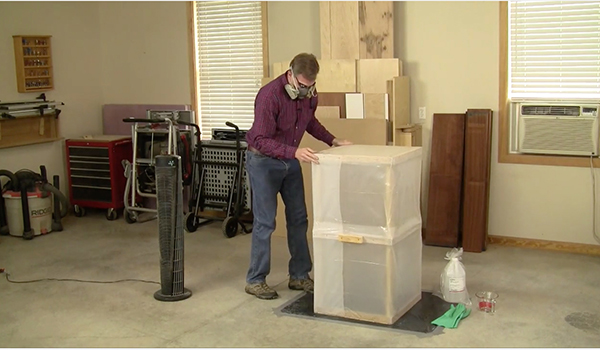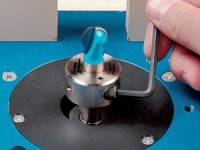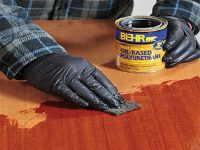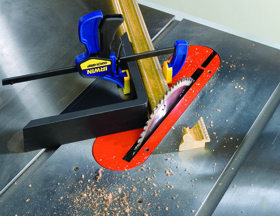Issue 186
Issue 186
Age-Old Carving Techniques Pass to New Generation
 Woodcarving is movement. By nature, it is more physical than cerebral. There are subtleties within subtleties and, as with dance or riding a bicycle, there is only so much that can be explained or described before the student must eventually delve in, preferably under the critical eye of the master.
Woodcarving is movement. By nature, it is more physical than cerebral. There are subtleties within subtleties and, as with dance or riding a bicycle, there is only so much that can be explained or described before the student must eventually delve in, preferably under the critical eye of the master.
At its foundation, instruction is nothing more than duplication. Duplicating the teacher’s movements, posture, etc., repetitiously until these techniques become second nature to the student. This is the value of observation. In my classes, I demonstrate. The students observe and duplicate many times over. There are not shortcuts. As an apprentice under my father, I was required to duplicate a particular cut hundreds of times.
This was how my father was instructed when he was a young apprentice many years before. With me, he was carrying on the master-apprentice tradition dating back to the Renaissance — perhaps earlier. In this way it was not unlike studying the violin or cello under a famous music teacher. The first five to 10 years were spent performing the unglamorous task of monotonous reproduction. Only in the master woodcarver’s studio, the object was to move the apprentice quickly from the position of novice to the point where he became an economic asset. Under these pressures, the method of instruction through the years became finely honed. Each master woodcarver had his own individual personality and style, yet remarkably, most of the techniques and methods remained similar throughout the centuries.
This is why woodcarving in Europe has such an easily identifiable stamp. This common thread — genetic code, if you will — is a direct result of a distinct and absolutely necessary approach to woodcarving beginning at the foundation. These are the fundamental techniques that are as valid today as they were during the Middle Ages. There are not many, and they are not complex. In truth, they are based in such a common sense approach that even my self-taught students who have been carving for years are surprised (and relieved) to find just how logical these techniques are, how much they improve in just one session. Even woodcarvers who have no intention of carving in the Old World European styles come away with a knowledge that is readily applied to any and all styles.
Throughout my 25+ years of sharing these “secrets” with my students in workshops and art schools across the nation, one of the greatest obstacles and regrets is that I cannot be there with these students when they take these newly acquired skills home with them to their own studios. Even great, accomplished dancers work closely with a coach on an ongoing basis, improving and refining their art as well as avoiding bad habits.
Not too long ago, we began tossing about the idea of producing a teaching video which the students could take home after a class to keep their skills fine-tuned. I began asking students if this appealed to them; it certainly did to me. But I was surprised to find a reluctance on their part. It turned out many had purchased videos in the past and were less than pleased with the results. Many were badly filmed, had incorrect lighting, not enough close-ups and left much to be desired. But I wasn’t ready to give up on the idea. The advantages were just too numerous. I set out on a mission to address the mistakes made by past videos and grew more and more excited at the prospects of instilling the ancient, common-sense techniques to not just a few hundred students a year, but to thousands of desiring woodcarvers, many who could never afford the travel expense or time off to attend one of my classes.
I’m proud to say, the feedback has been incredibly positive. With this video effort, my students (many of whom I will never meet) have been studying at their own pace, acquiring these ancient techniques and producing beautiful work as though they were receiving private instructions at my studio. No more problems with lighting, close-ups, etc. How can they go wrong when they can duplicate every detail from start to finish many, many times over?
I’m so encouraged that these age-old techniques of the past masters will live on in the abilities of a new generation in a way that the ancient artist could never have dreamed!
Q & A
-

Temps for Fuming Oak
Are there any temperature restrictions when fuming oak?
-

Quarter- to Half-Inch Adapter Collets?
Are there quarter-inch to half-inch adapters available that would let me use a half-inch set of cabinet door bits?
-

Difference Between Wipe-On and Brush Poly
What is the difference between wipe-on polyurethane and the brush-on? Can the brush-on also be wiped on?
-

Best Curved Stile to Rail Joinery
What joinery is best for fitting the door stiles to the rails for a curved china door cabinet?
Feedback
-

Pilot Holes, Good Caulk and Bad Grammar
A comment about drilling pilot holes for brass screws elicited a comment and a question.
What's In Store
-

Woodworker II Thin Kerf
Long a top performer, the Woodworker II is a general purpose blade that you can leave in your saw for a wide variety of cutting tasks.
-

Rockler Universal Fence Clamps
Rockler’s Universal Fence Clamps are an ultra-practical shop accessory.
-

50-560 10″ Scoring Saw
The 50-560 10″ Scoring Saw with Built-In Sliding Table from General International is a heavy-duty table saw is feature-rich.
-

Rockler 45 Degree Miter Sled: Getting Square
A new product from Rockler Woodworking and Hardware makes cutting perfect 45° miters a snap.
Today's Woodworker
-

Dimitrios Klitsas: Learning Woodcarving
“If you would like to learn woodcarving, you need to find a teacher;” advises Dimitrios Klitsas, an expatriate Greek carver who lives in Massachusetts.
Industry Interviews
-

Unimat: “Honest, Honey, I Bought It for the Kids”
All parents and grandparents know this simple truth: the best toys to buy for kids are the ones you want to play with after they are asleep.







